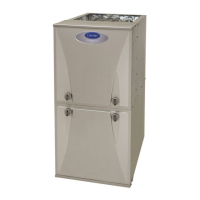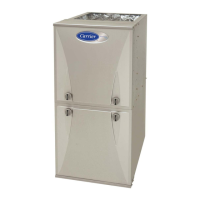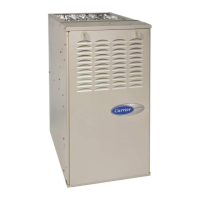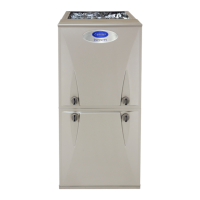PG92MSA: Installation, Start-up, Operating and Service and Maintenance Instructions
Manufacturer reserves the right to change, at any time, specifications and designs without notice and without obligations.
44
Installing the Vent Pipe Adapter and Combustion Air
Pipe Adapter
NOTE: The rubber coupling that attaches to the vent pipe adapter must
be used. The adapter seals the vent pipe to the casing and reduces the
strain on the vent elbow attached to the inducer.
1. Apply the gaskets to the vent pipe and combustion air pipe
adapters. If supplied, remove and discard round center “slug” from
interior of gasket. See Fig. 58.
A13074
Fig. 58 – Vent Coupling and Adapter with Gaskets
NOTE: The vent pipe adapter can be distinguished from the inlet pipe
adapter by the absence of an internal pipe-stopping ring. The vent pipe
can pass through the vent pipe adapter; it cannot pass through the inlet
pipe adapter.
2. Align the screw holes in the plastic vent pipe adapter with the
dimples in the casing.
3. Pilot drill the screw holes for the adapter in the casing and attach
the vent pipe adapter to the furnace with sheet metal screws
4. Slide the end of the rubber vent coupling with notches in it over the
standoffs on the vent pipe adapter.
5. Insert a length of vent pipe through the coupling into the outlet of
the vent elbow.
6. Tighten the clamp around the outlet of the vent elbow. Torque the
clamp to 15 lb-in.
Install the remaining vent and combustion air pipes as shown below. It is
recommended that all pipes be cut, prepared, and pre-assembled before
permanently cementing any joint.
1. Working from furnace to outside, cut pipe to required length(s).
2. De-burr inside and outside of pipe.
3. Chamfer outside edge of pipe for better distribution of primer and
cement.
4. Clean and dry all surfaces to be joined.
5. Check dry fit of pipe and mark insertion depth on pipe.
6. Insert the vent pipe into the vent elbow.
7. Torque clamp on vent elbow 15 lb-in.
8. Torque clamp on vent coupling 15 lb-in.
9. Insert the combustion air pipe into the adapter.
10. Pilot drill a screw hole through the adapter into the combustion air
pipe and secure the pipe to the adapter with sheet metal screws. DO
NOT DRILL INTO POLYPROPYLENE VENT PIPES. Use an
optional accessory vent coupling, if needed.
11. Seal around the combustion air pipe with silicone or foil tape.
SILICONE SEALERS MAY NOT BE APPROPRIATE FOR
POLYPROPYLENE VENT SYSTEMS. SEE
POLYPROPYLENE VENT SYSTEM MANUFACTURER’S
INSTRUCTIONS.
12. After pipes have been cut and pre-assembled, apply generous layer
of cement primer to pipe fitting socket and end of pipe to insertion
mark. Quickly apply approved cement to end of pipe and fitting
socket (over primer). Apply cement in a light, uniform coat on
inside of socket to prevent buildup of excess cement. Apply second
coat. DO NOT CEMENT POLYPROPYLENE FITTINGS.
13. While cement is still wet, twist pipe into socket with 1/4-in. turn.
Be sure pipe is fully inserted into fitting socket.
14. Wipe excess cement from joint. A continuous bead of cement will
be visible around perimeter of a properly made joint.
15. Handle pipe joints carefully until cement sets.
16. Horizontal portions of the venting system shall be supported to
prevent sagging. Space combustion air piping and vent piping
hangars as shown in Table 17. Support pipes using perforated metal
hanging strap or commercially available hangars or straps designed
to support plastic pipe.
Winter
Design
Temp
°C
Unit Size
120,000 BTUH
140,000 BTUH
Uninsulated 3/8-in. Insulation 1/2-in. Insulation Uninsulated 3/8-in. Insulation 1/2-in. Insulation
Pipe Dia.
mm
64 76 102 64 76 102 64 76 102 64 76 102 64 76 102 64 76 102
-7 3.0 15.2 12.2 3.0 22.9 28.9 3.0 22.9 32.0 1.5 16.7 15.2 1.5 19.8 32.0 1.5 19.8 38.1
-18 3.0 6.1 4.6 3.0 16.8 13.7 3.0 19.8 15.2 1.5 7.6 4.6 1.5 19.8 15.2 1.5 19.8 18.3
-29 3.0 3.0
3.0 10.7 7.6 3.0 13.7 9.1 1.5 3.0 1.5 1.5 13.7 9.1 1.5 15.2 12.2
-40 3.0 1.5
3.0 7.6 4.6 3.0 9.1 6.1 1.5 1.5 1.5 9.1 6.1 1.5 35 7.6
WARNING
!
CARBON MONOXIDE POISONING HAZARD
Failure to follow this warning could result in personal injury or death.
DO NOT use cement to join polypropylene venting systems. Follow
the polypropylene venting system manufacturer’s instructions for
installing polypropylene venting systems.
CAUTION
!
CARBON MONOXIDE POISONING HAZARD
Failure to follow this warning could result in personal injury or death.
To route the vent pipe and combustion air pipe through the furnace, the
manufacturer supplied kit must be used. Failure to properly seal the
blower compartment from the furnace vestibule could result in the
circulation of carbon monoxide throughout the structure. The vent pipe
and combustion air pipe must be a continuous pipe while passing
through the blower compartment. Seals supplied in this kit must be
installed per the instructions provided. Follow all procedures outlined
in these instructions.
Attach gaskets to vent pipe and
combustion air adapters.
Vent Coupling and Adapter
NOTICE
!
The following instructions are for PVC/ABS DWV vent piping only.
DO NOT USE THESE TECHNIQUES FOR POLYPROPYLENE
VENT PIPING SYSTEMS. See the polypropylene vent system
manufacturer’s instructions for installing polypropylene venting
systems.

